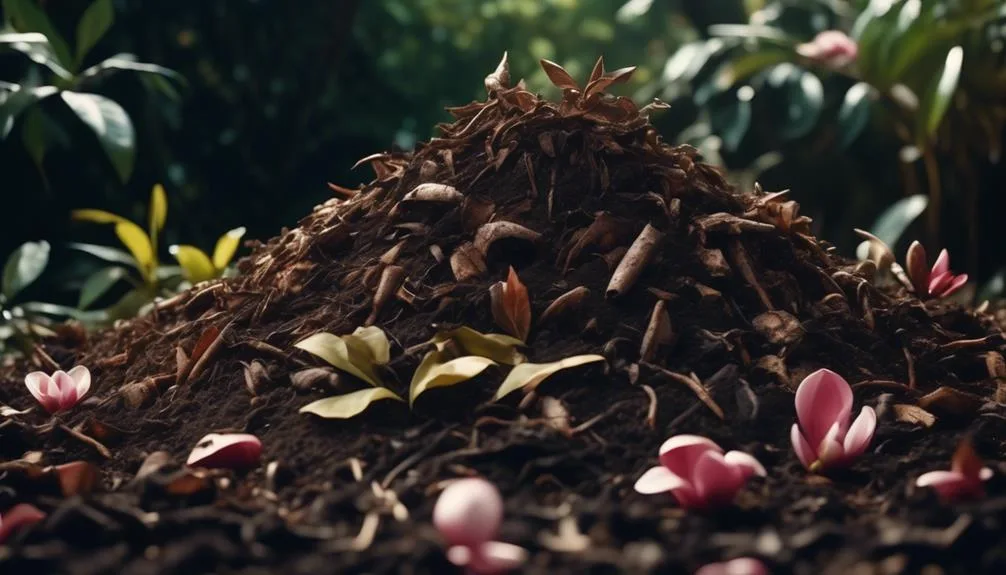Curious about using magnolia bark in your compost pile? Discover its potential benefits and impact on soil quality.
Before deciding, it's important to understand how magnolia bark could affect your compost. Let's explore the truth about its suitability for composting.
Nutrient Content of Magnolia Bark
When composting magnolia bark, it's important to understand its nutrient content to ensure a balanced and effective composting process.
Magnolia bark is rich in lignin, a complex organic polymer that decomposes slowly. This makes it a valuable addition to compost, providing long-term structural support to the soil.
Furthermore, the nutrient composition of magnolia bark includes essential elements such as nitrogen, phosphorus, and potassium, which are vital for supporting microbial activity in the compost pile. These nutrients aid in the breakdown of organic matter by providing energy sources for the diverse microbial community responsible for the decomposition process.
Understanding the nutrient composition of magnolia bark allows for the optimization of microbial activity, leading to the efficient transformation of the bark into nutrient-rich compost for your garden.
Decomposition Rate in Composting
Understanding the nutrient composition of magnolia bark not only enhances the microbial activity in your compost pile but also directly impacts the decomposition rate in composting. The decomposition rate is influenced by various factors including the carbon to nitrogen ratio, moisture levels, and microbial activity. Here's a breakdown of how magnolia bark contributes to these factors:
| Carbon to Nitrogen Ratio | Moisture Levels | Microbial Activity |
|---|---|---|
| Low | Moderate | High |
The carbon to nitrogen ratio of magnolia bark is relatively low, making it a great source of energy for the microbial organisms responsible for breaking down organic matter. Additionally, its moderate moisture levels help create an ideal environment for microbial activity, further accelerating the decomposition rate in your compost pile.
Impact on Soil Quality
Magnolia bark's contribution to soil quality is significant, as it enriches the soil with essential nutrients and promotes microbial activity, fostering a healthy environment for plant growth.
The bark enhances soil fertility by slowly releasing nutrients as it decomposes, providing a sustainable source of nourishment for plants. Furthermore, it promotes microbial activity, fostering a rich and diverse soil ecosystem. This enhances the soil's ability to break down organic matter and supports nutrient cycling, ultimately benefiting plant health.
Additionally, magnolia bark aids in water retention, helping the soil to maintain optimal moisture levels for plant growth. Its natural acidity also contributes to maintaining pH balance in the soil, creating an environment conducive to the uptake of essential nutrients by plants.
Considerations for Composting With Magnolia Bark
As you consider composting with magnolia bark, it's essential to take into account its impact on soil quality and the specific considerations involved in optimizing its benefits for your composting process.
When incorporating magnolia bark into your compost, you may encounter some challenges. Due to its high lignin content, magnolia bark can take longer to decompose compared to other materials. Therefore, it's important to shred or grind the bark into smaller pieces to facilitate the composting process.
Additionally, the environmental impact of magnolia bark should be considered. While it can provide valuable nutrients to the soil, using it in excess may alter the carbon-to-nitrogen ratio of the compost, affecting its overall quality.
Striking a balance in the use of magnolia bark in composting is crucial to ensure its positive effects on the environment and the composting process.
Best Practices for Using Magnolia Bark in Compost
To maximize the benefits of magnolia bark in your compost, consider shredding or grinding it into smaller pieces to facilitate the decomposition process and promote nutrient release. This allows for better aeration and faster breakdown. Here are some best practices for using magnolia bark in compost:
| Best Practices | Description | Benefits |
|---|---|---|
| Shredding | Break magnolia bark into smaller pieces | Facilitates decomposition process |
| Layering | Alternate layers of magnolia bark with other compost materials | Promotes balanced nutrient mix |
| Turning | Regularly turn the compost pile to mix in magnolia bark | Enhances aeration and decomposition |
| Moisture | Maintain optimal moisture levels in the compost | Supports microbial activity |
Adhering to these composting techniques will not only enhance the organic gardening benefits but also result in nutrient-rich compost for your plants.
Conclusion
Incorporating magnolia bark into your compost pile can significantly enhance its nutrient content, moisture retention, and aeration. Remember to chop it into smaller pieces and mix it well with other organic materials for optimal results.
Consider the impact this simple addition can have on enriching the soil and promoting sustainable gardening practices.
Happy composting!

My interest in trees started when I first saw the giant sequoias in Yosemite.
I was a teenager then, and I remember thinking, “I need to learn more about this.”
That moment stuck with me.
A few years later, I went on to study forestry at Michigan Tech.
Since graduating, I’ve worked in a mix of hands-on tree care and community education.
I’ve spent over ten years helping people understand how to plant, maintain, and protect the trees in their neighborhoods.
I don’t see trees as just part of the landscape.
They are living things that make a real difference in our daily lives.
